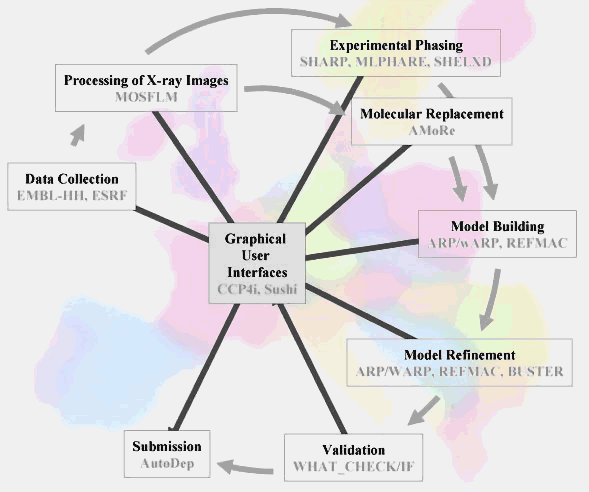

AUTOSTRUCT
Report by Alun Ashton, CCP4.


AUTOSTRUCT is the acronym for an EU supported project to bring together the efforts of many of the major European software developers for X-ray crystallography. The major objective is to make the procedures more effective, in terms of using more powerful algorithms to solve, refine and validate structures. The software should not only be as transparent as possible to the end user, but also assist in the case of user inexperience.
The project is barely a year old but much has already been achieved. DNA (DNA Not AUTOSTRUCT, http://www.dna.ac.uk) is an AUTOSTRUCT ‘spin off’ collaboration primarily between Daresbury Laboratory, MRC Laboratory of Molecular Biology, Cambridge and the ESRF. The primary aim is to facilitate communication between beamline data collection and control software and the data processing software. This will soon lead to real improvements for users on synchrotron beamlines. The ultimate aim of automating data collection has been helped by the adoption of the open XML standard as a communication protocol between software. This will undoubtedly enable any future expansions and reduce the time scale of implementing the procedure at other sites or beamlines.
Moving between packages such as SHARP, SHELX and CCP4 can occasionally be convoluted due to the evolution of individual standards for recording and reporting data formats (for example heavy atom positions). But now agreement on a common standard that will be implemented in all the mentioned packages is at an advanced stage. A route of easily accessing SHELXD within CCP4i is also under development.
Whether you derive your first map from direct methods, isomorphous replacement techniques or by molecular replacement (e.g. by the ever improving AMoRe package also receiving funding for developments under AUTOSTRUCT), automated model building and refinement makes life a whole lot easier. Undoubtedly one of the leaders in this field is the ARP/wARP procedure. As this package is heavily dependent on other programs such as REFMAC* a lot of work is being done to co-ordinate releases of these packages. Also ARP/wARP and CCP4 have collaborated to create an easily installable interface to run within CCP4i. The interface will exploit the full functionality of the ARP/wARP package and will be available soon with version 5.2 of ARP/wARP.
When thoughts turn towards structure validation and deposition you should probably also start thinking about the next project. AUTOSTRUCT can’t help you choose or find the next project but making validation and deposition easier is a goal! In one recent AUTOSTRUCT meeting not only was agreement reached on distributing the popular WHAT_CHECK validation package with future releases of CCP4 but also an interface within CCP4i was developed. Regular readers of the CCP4 newsletter will already be familiar with the concepts of Data Harvesting and work is continuing to expand and facilitate this process to enable fast and easy structure deposition.
For more information on AUTOSTRUCT keep an eye on the web pages at www.autostruct.org. The project is sponsored under the EU program: Quality of Life and Management of Living Resources. The project co-ordinator is Prof. Keith Wilson, York Structural Biology Laboratory.
List of Partners:
1 YSBL, University of York, http:/www.ysbl.york.ac.uk
2 Mosflm, LMB-MRC, http://www.mrc-lmb.cam.ac.uk/harry/mosflm
3 SHELX, Goettingen University, http://shelx.uni-ac.gwdg.de/SHELX/
4A EMBL Hamburg Outstation, http://www.embl-hamburg.de
4B EMBL European Bioinformatics Institute, http://www.ebi.ac.uk
5 AMoRe, CNRS, http://www.ccp4.ac.uk/ccp4/html/amore.html
6 WHAT_CHECK, http://www.cmbi.kun.nl/whatif
7 CCP4, http://www.ccp4.ac.uk
8 NKI, http://www.arp-warp.org
9 GlobalPhasing, http://www.globalphasing.com